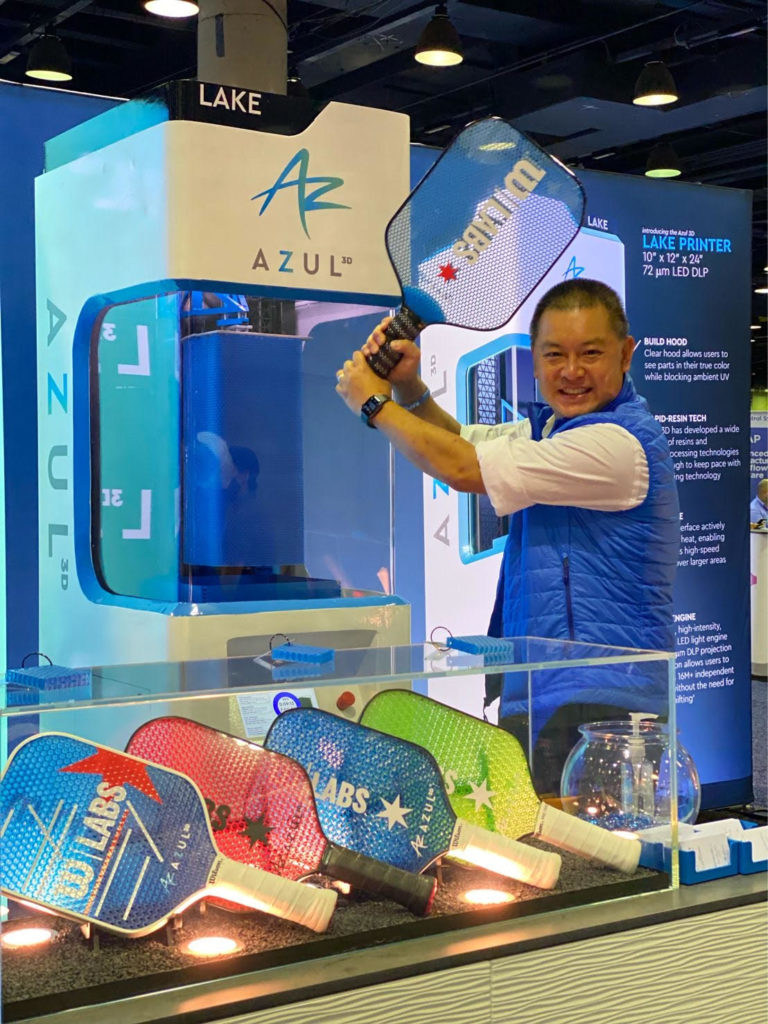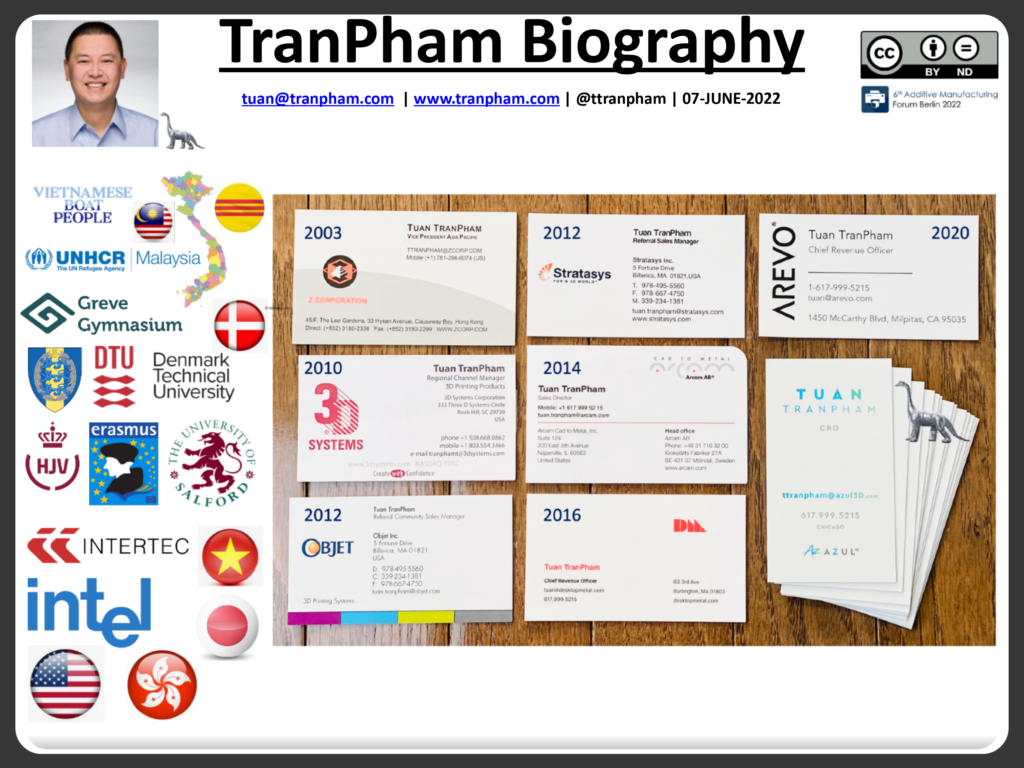Tuan TranPham is a 3D printing veteran—in fact, an official Additive Manufacturing Users Group DiNO—and is the most followed person in the additive manufacturing (AM) industry on LinkedIn. With an AM career dating back 20 years, TranPham has amassed experience working at both 3D printing stalwarts, like Stratasys (Nasdaq: SSYS) and 3D Systems (NYSE: DDD), but at startups like Desktop Metal (NYSE: DM), Arevo, and Azul 3D. I caught up with Tuan to learn about his overall history in the industry and how he came to have over 33,000 followers on LinkedIn.
Who is Tuan TranPham?
While most in the AM sector know Tuan either from his cordial conversations at trade shows or his graphic insights on social media, they may be less familiar with the TranPham backstory. Born in Ho Chi Minh City (Saigon), Vietnam, he and his family fled their homeland by boat during the border dispute with China in 1979. The three-day trip saw a five-year-old Tuan living in a United Nations refugee camp for six months before his family found permanent residence in Copenhagen, Denmark.
“A lot of people don’t know this, but I’m actually a Vietnamese boat refugee,” Tuan said. “It’s kind of funny. It turns out that my boss at Arevo, the carbon fiber 3D printing startup, was in the same refugee camp in the same year, at the same time. We might have actually met back then, but I’m not sure because I was barely five.”
Denmark is one of a few countries with mandatory military conscription, which meant that TranPham had to serve, which he did both in mobile infantry and in the National Guard. After completing a major in business and engineering, he participated in the EU student exchange program that saw him live in Manchester for a year.
His business career kicked off in earnest in 1999, while still studying Tuan opted to work for a Danish company as an Intern (instead of staying in Denmark) in Hanoi, Vietnam, where his language skills meant that he could obtain a more responsibilities than if he’d remained in Denmark. He took a position at a small Cisco reseller, which was acquired, and then GIGA A/S, a manufacturer of networking chips that was bought by Intel in Copenhagen. At $1.25 billion in cash, this was the most valuable acquisition in Danish history.
As an employee at Intel, Tuan now had what he would need to make his way to the U.S. in 2002, Boston, Massachusetts specifically, where he has more or less lived ever since except for two years in Hong Kong. While he made the move for a woman, who would become his wife, it was also through that relocation that he’d find his “accidental passion” of 3D printing.
The Early Days of 3D Printing
“My wife went to a Boston University reunion party and a friend of a friend was the financial controller at Z Corp. They were looking for someone for Asia. And I ran Asia Pacific for my GiGA/Intel product line for Intel, so I knew Asia Pacific. So that’s how I bumped into 3D printing at 29 years old,” TranPham said. “And I fell in love with it. I thought, ‘This is gonna be big.’”
Just as Tuan had been at the right place at the right time when GIGA was acquired, he also navigated the world of 3D printing during one of its most tumultuous times. Starting at Z Corp, who licensed MIT’s binder jetting technology to 3D print full color objects made from gypsum powder, he then went to 3D Systems, which opted to purchase his old employer.
 An old Z Corp binder jet 3D printer for sale on eBay.
An old Z Corp binder jet 3D printer for sale on eBay.“I was running Z Corp Asia Pacific—built a team, a rep office, a service application marketing team. I actually volunteered to move to Hong Kong to build the operation,” TranPham said. “When the recession hit, I was laid off. That’s when I joined 3D Systems in 2010.”
As one of three channel managers, Tuan educated the distributors, made up of the major CAD resellers, about the technology. Before he left in late 2011, he was establishing the channel for the Bits to Bytes desktop 3D printer for 3D Systems.
Next was Objet, who impressed him with the multi-material capabilities of its PolyJet technology. Four months later and the Israeli firm merged with Stratasys, where he tried to convince management to purchase electron beam melting (EBM) pioneer Arcam. When that didn’t work, he opted to work for Swedish Arcam directly, but with a nine-month stopover at 3D rendering firm KeyShot until Arcam was ready to take him on.
“When I tallied up all of the industrial systems in 2013, there were 55,000. Less than two percent were in metals. At all of the trade shows, all of the exhibitors were polymer. There was a little bit of metal, but nobody paid attention. So, I got excited. I thought about what if it went to three or four percent. That’s when I resigned to join Arcam.”
Birth of a 3D Printing Influencer
Tuan actually attributes his move to Arcam with his use of LinkedIn. The 3D printing veteran took up the social media site circa 2007, when 3D printing was still emerging as a production tool.
“My wife was a Goldman Sachs tax attorney and worked crazy hours, as you can imagine. That meant that I had a lot of time in my evenings and weekend. So, what could I do in the office? I did my actual work building the Z Corp distribution channel, but I also decided to join LinkedIn Professional in the evenings. There were only 12 million people on the entire global platform. I thought, this is a great platform because basically you have a a global deck of millions of resumes and it’s going to be so powerful because what touches us all is having a job to feed your family, right?”
He said that the companies he worked for didn’t tend to have social media, so he began posting from his personal account.
“You don’t know where your next prospect could be, but if you have enough voice and act as a lighthouse, the right people will come to you,” Tuan said. “But here’s an interesting insight: it is just as easy to click follow as it is to unfollow. The real challenge is actually getting followers who want to follow you because they can just click unfollow. For that, you need to create value in the noise of social media.”
To achieve this, TranPham tries to share only positive content, inspiring sights from the world of 3D printing, and his own insights. He shares credit along the way, thus boosting the individuals he follows in the industry. With over 33,000 followers, he now has a wider reach on the social media platform than even most any 3D printing companies.
 Tuan Tranpham, Former Chief Revenue Officer for Azul 3D, at the startup’s RAPID booth.
Tuan Tranpham, Former Chief Revenue Officer for Azul 3D, at the startup’s RAPID booth.LinkedIn for Work
As a lighthouse in the dark seas of social media, Tuan says that his early presence on the site has actually helped him to find work and progress his career.
“I attribute the Arcam job to LinkedIn because my data made Magnus [René, former CEO of Arcam] question his peers and what data they had given him because they weren’t factual,” TranPham said. “That was enough to get interest for him when he was in Boston to come to my house and have coffee with me, to pick my mind and find out who was this guy with market insights and contacts.”
While at Arcam, he was able to educate himself further about metal 3D printing technologies, thanks in large part to his colleague Francisco Medina, the company’s senior materials specialist at the time. He then used the site to share the insights he gained at a time when there was still confusion in the mainstream media about 3D printing as a whole. He would then get feedback from the community, which would only further teach him about the technology.
“What people don’t realize is that you learn just as much by sharing because, when I share a slide on the site, I get better because of the feedback. And the community has actually been very constructive. People also fear that there’ll be trolls and you’re going to be shut down because you don’t know what you’re doing. But I found that by sharing some insight, you actually get good feedback that will make your content better for the next revision,” Tuan said.
In turn, he believes he was able to obtain his next position at Desktop Metal. Leaving Arcam just as its acquisition by GE was being completed, an emerging startup was looking to staff its operations with leading experts from the sector. Its CEO and founder Ric Fulop came across Tuan, who consistently shared what he learned about metal 3D printing online, inspiring Fulop to reach out to him.
Now, as 3D printing undergoes yet another major upheaval, Tuan has a unique perspective offer, having lived through one or two others in the past. In our next installment in this series, we speak to Tuan TranPham about his point of view on the current merger activity surrounding Stratasys.
Subscribe to Our Email Newsletter
Stay up-to-date on all the latest news from the 3D printing industry and receive information and offers from third party vendors.
You May Also Like
Further Understanding of 3D Printing Design at ADDITIV Design World
ADDITIV is back once again! This time, the virtual platform for additive manufacturing will be holding the first-ever edition of ADDITIV Design World on May 23rd from 9:00 AM –...
3D Printer Maker EVO-tech Reborn as NEVO3D — Once More With Feeling
EVO-tech was a 3D printing service and original equipment manufacturer established in 2013 and based in Schörfling am Attersee, Austria. The company produced high-quality material extrusion systems featuring linear bearings,...
3D Systems Brings 3D Printed PEEK Cranial Implant to the U.S. with FDA Clearance
For more than 10 years, 3D Systems (NYSE:DDD) has worked hand-in-hand with surgeons to plan over 150,000 patient-specific cases, and develop more than two million instruments and implants from its...
CDFAM Returns to Berlin for Second Annual Symposium
The second CDFAM Computational Design Symposium is scheduled for May 7-8, 2024, in Berlin, and will convene leading experts in computational design across all scales. Building upon the first event...

































